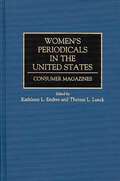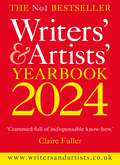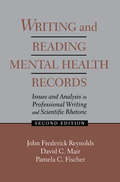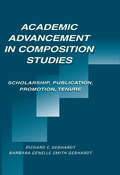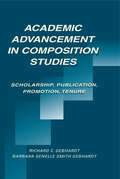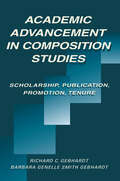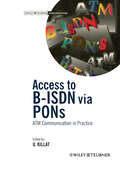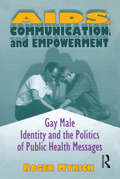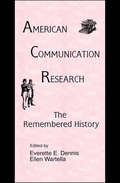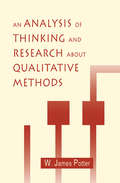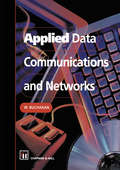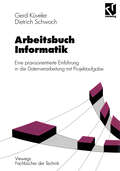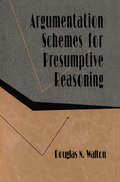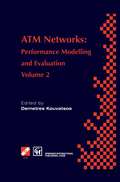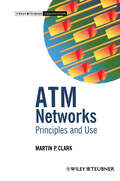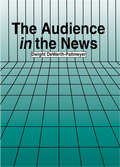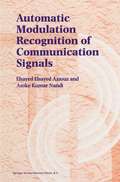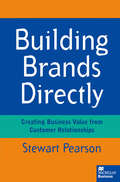- Table View
- List View
Women's Periodicals in the United States: Consumer Magazines (Historical Guides to the World's Periodicals and Newspapers)
by Kathleen L. Endres Therese LueckConsumer magazines aimed at women are as diverse as the market they serve. Some are targeted to particular age groups, while others are marketed to different socioeconomic groups. These magazines are a reflection of the needs and interests of women and the place of women in American society. Changes in these magazines mirror the changing interests of women, the increased purchasing power of women, and the willingness of advertisers and publishers to reach a female audience.This reference book is a guide to women's consumer magazines published in the United States. Included are profiles of 75 magazines read chiefly by women. Each profile discusses the publication history and social context of the magazine and includes bibliographical references and a summary of publication statistics. Some of the magazines included started in the 19th century and are no longer published. Others have been available for more than a century, while some originated in the last decade. An introductory chapter discusses the history of U.S. consumer women's magazines, and a chronology charts their growth from 1784 to the present.
Writers' & Artists' Yearbook 2024: The best advice on how to write and get published (Writers' and Artists')
by Bloomsbury Publishing'WAYB remains an indispensable companion for anyone seriously committed to the profession of author, whether full-time or part-time; and as always it is particularly valued by those who are setting out hopefully on that vocational path.' - David LodgeRevised and updated annually, this bestselling guide includes over 3,500 industry contacts across 12 sections and 80 plus articles from writers across all forms and genres, including award-winning novelists, poets, screenwriters and bloggers. The Yearbook provides up-to-date advice, practical information and inspiration for writers at every stage of their writing and publishing journey.If you want to find a literary or illustration agent or publisher, would like to self-publish or crowdfund your creative idea then this Yearbook will help you. As well as sections on publishers and agents, newspapers and magazines, illustration and photography, theatre and screen, there is a wealth of detail on the legal and financial aspects of being a writer or illustrator.Additional articles, free advice, events information and editorial services at www.writersandartists.co.uk
Writing and Reading Mental Health Records: Issues and Analysis in Professional Writing and Scientific Rhetoric
by J. Frederick Reynolds David C. Mair Pamela C. FischerThis revised and updated second edition is a rhetorical analysis of written communication in the mental health community. As such, it contributes to the growing body of research being done in rhetoric and composition studies on the nature of writing and reading in highly specialized professional discourse communities. Many compelling questions answered in this volume include: * What "ideological biases" are reflected in the language the nurse/rhetorician uses to talk to and talk about the patient? * How does language figure into the process of constructing meaning in this context? * What social interactions -- with the patient, with other nurses, with physicians -- influence the nurse's attempt to construct meaning in this context? * How do the readers of assessment construct their own meanings of the assessment? Based on an ongoing collaboration between composition studies specialists and mental health practitioners, this book presents research of value not only to writing scholars and teachers, but also to professional clinicians, their teachers, and those who read mental health records in order to make critically important decisions. It can also be valuable as a model for other scholars to follow when conducting similar long-range studies of other writing-intensive professions.
Writing and Reading Mental Health Records: Issues and Analysis in Professional Writing and Scientific Rhetoric
by J. Frederick Reynolds David C. Mair Pamela C. FischerThis revised and updated second edition is a rhetorical analysis of written communication in the mental health community. As such, it contributes to the growing body of research being done in rhetoric and composition studies on the nature of writing and reading in highly specialized professional discourse communities. Many compelling questions answered in this volume include: * What "ideological biases" are reflected in the language the nurse/rhetorician uses to talk to and talk about the patient? * How does language figure into the process of constructing meaning in this context? * What social interactions -- with the patient, with other nurses, with physicians -- influence the nurse's attempt to construct meaning in this context? * How do the readers of assessment construct their own meanings of the assessment? Based on an ongoing collaboration between composition studies specialists and mental health practitioners, this book presents research of value not only to writing scholars and teachers, but also to professional clinicians, their teachers, and those who read mental health records in order to make critically important decisions. It can also be valuable as a model for other scholars to follow when conducting similar long-range studies of other writing-intensive professions.
Academic Advancement in Composition Studies: Scholarship, Publication, Promotion, Tenure
by Richard C. Gebhardt Barbara Genelle Smith GebhardtThis volume deals with a number of related issues that are becoming increasingly crucial for English studies during this time when most faculty in the field are assistant professors approaching tenure review or associate professors seeking promotion. These critical issues focus on: * The diversity of research and scholarly publication in composition studies; * The fact that composition studies faculty are often evaluated by personnel committee members, department chairs, and deans unfamiliar with the nature and demands of the field; * The way that American higher education is rethinking "scholarship" and the role it plays in the work and evaluation of faculty members; and * The role composition studies faculty can play in this review of scholarship and professional advancement. This book seeks to address the entire spectrum of "composition studies" -- expository and argumentative writing, personal essay, literary nonfiction, technical and business writing, historical rhetoric, empirical research, and more -- by understanding the nature of and evaluating the work of faculty members in this broad field. Scholarship and advancement issues are discussed in a variety of situations including basic and regular first-year composition classes at four-year and two-year institutions or writing centers, advanced writing courses, ESL and skills-development programs, and writing classes and programs for teachers, administrators, and researchers. The chapters focus on a variety of subjects, including the importance of mentoring and faculty development in all departments and institutions; and how young scholar-teachers and assistant professors can prepare for a successful personnel or tenure review.
Academic Advancement in Composition Studies: Scholarship, Publication, Promotion, Tenure
by Richard C. Gebhardt Barbara Genelle Smith GebhardtThis volume deals with a number of related issues that are becoming increasingly crucial for English studies during this time when most faculty in the field are assistant professors approaching tenure review or associate professors seeking promotion. These critical issues focus on: * The diversity of research and scholarly publication in composition studies; * The fact that composition studies faculty are often evaluated by personnel committee members, department chairs, and deans unfamiliar with the nature and demands of the field; * The way that American higher education is rethinking "scholarship" and the role it plays in the work and evaluation of faculty members; and * The role composition studies faculty can play in this review of scholarship and professional advancement. This book seeks to address the entire spectrum of "composition studies" -- expository and argumentative writing, personal essay, literary nonfiction, technical and business writing, historical rhetoric, empirical research, and more -- by understanding the nature of and evaluating the work of faculty members in this broad field. Scholarship and advancement issues are discussed in a variety of situations including basic and regular first-year composition classes at four-year and two-year institutions or writing centers, advanced writing courses, ESL and skills-development programs, and writing classes and programs for teachers, administrators, and researchers. The chapters focus on a variety of subjects, including the importance of mentoring and faculty development in all departments and institutions; and how young scholar-teachers and assistant professors can prepare for a successful personnel or tenure review.
Academic Advancement in Composition Studies: Scholarship, Publication, Promotion, Tenure
by Richard C. Gebhardt Barbara Genelle Smith GebhardtThis volume deals with a number of related issues that are becoming increasingly crucial for English studies during this time when most faculty in the field are assistant professors approaching tenure review or associate professors seeking promotion. These critical issues focus on: * The diversity of research and scholarly publication in composition studies; * The fact that composition studies faculty are often evaluated by personnel committee members, department chairs, and deans unfamiliar with the nature and demands of the field; * The way that American higher education is rethinking "scholarship" and the role it plays in the work and evaluation of faculty members; and * The role composition studies faculty can play in this review of scholarship and professional advancement. This book seeks to address the entire spectrum of "composition studies" -- expository and argumentative writing, personal essay, literary nonfiction, technical and business writing, historical rhetoric, empirical research, and more -- by understanding the nature of and evaluating the work of faculty members in this broad field. Scholarship and advancement issues are discussed in a variety of situations including basic and regular first-year composition classes at four-year and two-year institutions or writing centers, advanced writing courses, ESL and skills-development programs, and writing classes and programs for teachers, administrators, and researchers. The chapters focus on a variety of subjects, including the importance of mentoring and faculty development in all departments and institutions; and how young scholar-teachers and assistant professors can prepare for a successful personnel or tenure review.
Academic Advancement in Composition Studies: Scholarship, Publication, Promotion, Tenure
This volume deals with a number of related issues that are becoming increasingly crucial for English studies during this time when most faculty in the field are assistant professors approaching tenure review or associate professors seeking promotion. These critical issues focus on: * The diversity of research and scholarly publication in composition studies; * The fact that composition studies faculty are often evaluated by personnel committee members, department chairs, and deans unfamiliar with the nature and demands of the field; * The way that American higher education is rethinking "scholarship" and the role it plays in the work and evaluation of faculty members; and * The role composition studies faculty can play in this review of scholarship and professional advancement. This book seeks to address the entire spectrum of "composition studies" -- expository and argumentative writing, personal essay, literary nonfiction, technical and business writing, historical rhetoric, empirical research, and more -- by understanding the nature of and evaluating the work of faculty members in this broad field. Scholarship and advancement issues are discussed in a variety of situations including basic and regular first-year composition classes at four-year and two-year institutions or writing centers, advanced writing courses, ESL and skills-development programs, and writing classes and programs for teachers, administrators, and researchers. The chapters focus on a variety of subjects, including the importance of mentoring and faculty development in all departments and institutions; and how young scholar-teachers and assistant professors can prepare for a successful personnel or tenure review.
Access to B-ISDN via PONs: ATM Communication in Practice
by Ulrich KillatIt is with great pleasure that I respond to the kind invitation of the BAF project to contribute prefatory remarks to this account of their work, carried out under the auspices of the RACE Programme (Research and Development in Advanced Communications in Europe). The objective of the RACE Programme was to support the intro duction of Integrated Broadband Communications in the European Union. An important part of this overall objective was served by the BAF project, which has aimed to produce a cost-effective access facility for broadband networks, especially for residential and small business customers. As this book relates, in order to do so the project consortium merged two advanced communications technologies, ATM and PON, with contributions from many other disciplines, to create a demon strator which has been subject to extensive trials and testing which have been fruitful both in contributions to international standards and in development work to improve further future generations of the system. This book forms an important reference source through the experience gained in this unique experiment in advanced telecommunications. Another significant feature of the project should not be overlooked however. When the European Commission first began looking at supporting industrial research in Europe in the mid-1980s, it was clear that we had important strengths in telecommunications. It was equally clear that a revolution was on the way - the digital revolution - and European pre-eminence in the field was not guaranteed for ever.
AIDS, Communication, and Empowerment: Gay Male Identity and the Politics of Public Health Messages
by Roger MyrickAIDS, Communication, and Empowerment examines the cultural construction of gay men in light of discourse used in the media’s messages about HIV/AIDS--messages often represented as educational, scientific, and informational but which are, in fact, politically charged. The book offers a compelling and substantive look at the social consequences of communication about HIV/AIDS and the reasons for the successes and failures of contemporary health communication. This analysis is important because it provides a reading of health communication from a marginal perspective, one that has often been kept silent in mainstream academic research. AIDS, Communication, and Empowerment offers a critical, historical analysis of public health communication about HIV/AIDS; the ways this communication makes sense historically and culturally; and the implications such messages have for the marginal group which has been most stigmatized as a consequence of these messages. It covers such topics as: the relationship among gay identity, language, and power cultural studies of the historical development of gay identity studies in health communication about HIV/AIDS and health risk communication the political consequences of public health education about HIV/AIDS on gay men the political consequences of media representations of gay identity and its relationship to disease Based primarily on the French scholar Michel Foucault’s critical, historical analysis of discourse and sexuality, this book takes a timely and original approach which differs from traditional, quantitative communication studies. It examines the relationship between language and culture using a qualitative, cultural studies approach which places medicalization theories in the broader context of histories of sexuality, the discursive development of contemporary gay identity, and recent public health communication.Author Roger Myrick explains how mainstream communication about HIV/AIDS relentlessly stigmatizes and further marginalizes gay identity. He describes how national health education stigmatizes groups by associating them with images of disease and “otherness.” Even communication which originates from marginal groups, particularly those relying on federal funds, often participates in linking gay identities with disease. According to Myrick, government funding, while often necessary for the continuation of community-based health campaigns, poses obvious and direct restrictions on effective marginal education. AIDS, Communication, and Empowerment allows for a rethinking of ways marginal groups can take control of their own education on public health issues. As HIV/AIDS cases continue to rise dramatically among marginalized and disenfranchised groups, analysis of health communication directed toward them becomes crucial to their survival. This book provides valuable insights and information for scholars, professionals, readers interested in the relationship among language, power and marginal identity, and for classes in gay and lesbian studies, health communication, or political communication.
AIDS, Communication, and Empowerment: Gay Male Identity and the Politics of Public Health Messages
by Roger MyrickAIDS, Communication, and Empowerment examines the cultural construction of gay men in light of discourse used in the media’s messages about HIV/AIDS--messages often represented as educational, scientific, and informational but which are, in fact, politically charged. The book offers a compelling and substantive look at the social consequences of communication about HIV/AIDS and the reasons for the successes and failures of contemporary health communication. This analysis is important because it provides a reading of health communication from a marginal perspective, one that has often been kept silent in mainstream academic research. AIDS, Communication, and Empowerment offers a critical, historical analysis of public health communication about HIV/AIDS; the ways this communication makes sense historically and culturally; and the implications such messages have for the marginal group which has been most stigmatized as a consequence of these messages. It covers such topics as: the relationship among gay identity, language, and power cultural studies of the historical development of gay identity studies in health communication about HIV/AIDS and health risk communication the political consequences of public health education about HIV/AIDS on gay men the political consequences of media representations of gay identity and its relationship to disease Based primarily on the French scholar Michel Foucault’s critical, historical analysis of discourse and sexuality, this book takes a timely and original approach which differs from traditional, quantitative communication studies. It examines the relationship between language and culture using a qualitative, cultural studies approach which places medicalization theories in the broader context of histories of sexuality, the discursive development of contemporary gay identity, and recent public health communication.Author Roger Myrick explains how mainstream communication about HIV/AIDS relentlessly stigmatizes and further marginalizes gay identity. He describes how national health education stigmatizes groups by associating them with images of disease and “otherness.” Even communication which originates from marginal groups, particularly those relying on federal funds, often participates in linking gay identities with disease. According to Myrick, government funding, while often necessary for the continuation of community-based health campaigns, poses obvious and direct restrictions on effective marginal education. AIDS, Communication, and Empowerment allows for a rethinking of ways marginal groups can take control of their own education on public health issues. As HIV/AIDS cases continue to rise dramatically among marginalized and disenfranchised groups, analysis of health communication directed toward them becomes crucial to their survival. This book provides valuable insights and information for scholars, professionals, readers interested in the relationship among language, power and marginal identity, and for classes in gay and lesbian studies, health communication, or political communication.
American Communication Research: The Remembered History (Routledge Communication Series)
by Everette E. Dennis Ellen WartellaThis book captures the essence of a never-to-be-repeated glimpse at the history of media research. It offers a unique examination of the origins, meaning, and impact of media and communication research in America, with links to European antecedents. Based on a high-level seminar series at Columbia University's Freedom Forum Media Studies Center, the book features work by leading scholars, researchers, and media executives. Participants in the series have called the program "heroic and unprecedented." The book encompasses essays, commentaries, and reports by such leading figures as William McGuire, Elihu Katz, and Leo Bogart, plus posthumous reports by Wilbur Schramm, Malcolm Beville, and Hilde Himmelweit. It also contains original insights on the collaboration of Frank Stanton, Paul Lazarfeld, and Robert K. Merton.
American Communication Research: The Remembered History (Routledge Communication Series)
by Everette E. Dennis Ellen Ann WartellaThis book captures the essence of a never-to-be-repeated glimpse at the history of media research. It offers a unique examination of the origins, meaning, and impact of media and communication research in America, with links to European antecedents. Based on a high-level seminar series at Columbia University's Freedom Forum Media Studies Center, the book features work by leading scholars, researchers, and media executives. Participants in the series have called the program "heroic and unprecedented." The book encompasses essays, commentaries, and reports by such leading figures as William McGuire, Elihu Katz, and Leo Bogart, plus posthumous reports by Wilbur Schramm, Malcolm Beville, and Hilde Himmelweit. It also contains original insights on the collaboration of Frank Stanton, Paul Lazarfeld, and Robert K. Merton.
An Analysis of Thinking and Research About Qualitative Methods (Routledge Communication Series)
by W. James PotterWritten for social science scholars who want to learn more about the qualitative way of thinking, this book addresses the full continuum of issues about the qualitative methodologies. At one end of that continuum are the deeply philosophical concerns of ontology and epistemology. At the other -- concrete -- end of that continuum are the practical issues of what is considered evidence: How does one go about gathering evidence? Where, when, and how does one analyze evidence? What are the alternative ways of dealing with tone and voice in writing qualitative research? The attention to practical, concrete issues makes this book useful as a handbook providing a great deal of vital information to scholars who want a guide to making decisions as they navigate their research questions through the qualitative realm. Uniquely qualified to write such a book, Potter has earned PhDs in both qualitative methods (with a concentration in linguistics and field studies) and in quantitative methods (with a concentration in social science theory and statistics). The book is not an ideological argument that glorifies one system of thinking while attempting to persuade the reader that other systems of thinking are bankrupt. Rather, the book presents a respectful, balanced analysis of the strengths and weaknesses of the qualitative approach. The book builds to a controversial final chapter entitled "Is Convergence a Possibility?" in which Potter synthesizes a conclusion from his analysis of a wide range of qualitative studies across three broad topic areas -- text focused research, audience focused research, and institution focused research -- and across seven major qualitative methodologies -- ethnography, ethnomethodology, reception study, ecological psychology, symbolic interactionism, cultural studies, and textual analysis. His conclusion is that not only is there a possibility of a convergence between qualitative and quantitative approaches, but that the convergence has already happened. The book includes an appendix in which 95 books and articles using the qualitative approach are abstracted and analyzed to illustrate key points of methodology and methods. It also includes subject and author indexes.
An Analysis of Thinking and Research About Qualitative Methods (Routledge Communication Series)
by W. James PotterWritten for social science scholars who want to learn more about the qualitative way of thinking, this book addresses the full continuum of issues about the qualitative methodologies. At one end of that continuum are the deeply philosophical concerns of ontology and epistemology. At the other -- concrete -- end of that continuum are the practical issues of what is considered evidence: How does one go about gathering evidence? Where, when, and how does one analyze evidence? What are the alternative ways of dealing with tone and voice in writing qualitative research? The attention to practical, concrete issues makes this book useful as a handbook providing a great deal of vital information to scholars who want a guide to making decisions as they navigate their research questions through the qualitative realm. Uniquely qualified to write such a book, Potter has earned PhDs in both qualitative methods (with a concentration in linguistics and field studies) and in quantitative methods (with a concentration in social science theory and statistics). The book is not an ideological argument that glorifies one system of thinking while attempting to persuade the reader that other systems of thinking are bankrupt. Rather, the book presents a respectful, balanced analysis of the strengths and weaknesses of the qualitative approach. The book builds to a controversial final chapter entitled "Is Convergence a Possibility?" in which Potter synthesizes a conclusion from his analysis of a wide range of qualitative studies across three broad topic areas -- text focused research, audience focused research, and institution focused research -- and across seven major qualitative methodologies -- ethnography, ethnomethodology, reception study, ecological psychology, symbolic interactionism, cultural studies, and textual analysis. His conclusion is that not only is there a possibility of a convergence between qualitative and quantitative approaches, but that the convergence has already happened. The book includes an appendix in which 95 books and articles using the qualitative approach are abstracted and analyzed to illustrate key points of methodology and methods. It also includes subject and author indexes.
Applied Data Communications and Networks
by B. BuchananThe usage of data communications and computer networks are ever in creasing. It is one of the few technological areas which brings benefits to most of the countries and the peoples of the world. Without it many industries could not exist. It is the objective of this book to discuss data communications in a readable form that students and professionals all over the world can understand. As much as possible the text uses dia grams to illustrate key points. Most currently available data communications books take their view point from either a computer scientists top-down approach or from an electronic engineers bottom-up approach. This book takes a practical ap proach and supports it with a theoretical background to create a textbook which can be used by electronic engineers, computer engineers, computer scientists and industry professionals. It discusses most of the current and future key data communications technologies, including: • Data Communications Standards and Models; • Local Area Networks (Ethernet, Token Ring and FDDI); • Transmission Control ProtocollInternet Protocol (TCPIIP); • High-level Data Link Control (HDLC); • X.25 Packet-switching; • Asynchronous Communications (RS-232) and Modems; • Pulse Coded Modulation (PCM); • Integrated Digital Services Network (ISDN); • Asynchronous Transfer Mode (ATM); • Error Control; • X-Windows. The chapters are ordered in a possible structure for the presentation of the material and have not been sectioned into data communications areas.
Arbeitsbuch Informatik: Eine praxisorientierte Einführung in die Datenverarbeitung mit Projektaufgabe (Viewegs Fachbücher der Technik)
by Gerd Küveler Dietrich SchwochLehrbuch für Erstausbildung in der Datenverarbeitung mit Projektaufgabe: Aufbau und Test einer meßtechnischen Schnittstellenkarte für den PC. Alle grundlegenden Themengebiete sind hier in einem Band vereinigt: Grundprinzipien, Umgang mit DOS, Programmieren mit Turbo Pascal, Mikrocomputersysteme, Betriebssysteme und Rechnernetze.
Argumentation Schemes for Presumptive Reasoning
by Douglas WaltonRecent concerns with the evaluation of argumentation in informal logic and speech communication center around nondemonstrative arguments that lead to tentative or defeasible conclusions based on a balance of considerations. Such arguments do not appear to have structures of the kind traditionally identified with deductive and inductive reasoning, but are extremely common and are often called "plausible" or "presumptive," meaning that they are only provisionally acceptable even when they are correct. How is one to judge, by some clearly defined standard, whether such arguments are correct or not in a given instance? The answer lies in what are called argumentation schemes -- forms of argument (structures of inference) that enable one to identify and evaluate common types of argumentation in everyday discourse. This book identifies 25 argumentation schemes for presumptive reasoning and matches a set of critical questions to each. These two elements -- the scheme and the questions -- are then used to evaluate a given argument in a particular case in relation to a context of dialogue in which the argument occurred. In recent writings on argumentation, there is a good deal of stress placed on how important argumentation schemes are in any attempt to evaluate common arguments in everyday reasoning as correct or fallacious, acceptable or questionable. However, the problem is that the literature thus far has not produced a precise and user-friendly enough analysis of the structures of the argumentation schemes themselves, nor have any of the documented accounts been as helpful, accessible, or systematic as they could be, especially in relation to presumptive reasoning. This book solves the problem by presenting the most common presumptive schemes in an orderly and clear way that makes them explicit and useful as precisely defined structures. As such, it will be an indispensable tool for researchers, students, and teachers in the areas of critical thinking, argumentation, speech communication, informal logic, and discourse analysis.
Argumentation Schemes for Presumptive Reasoning
by Douglas WaltonRecent concerns with the evaluation of argumentation in informal logic and speech communication center around nondemonstrative arguments that lead to tentative or defeasible conclusions based on a balance of considerations. Such arguments do not appear to have structures of the kind traditionally identified with deductive and inductive reasoning, but are extremely common and are often called "plausible" or "presumptive," meaning that they are only provisionally acceptable even when they are correct. How is one to judge, by some clearly defined standard, whether such arguments are correct or not in a given instance? The answer lies in what are called argumentation schemes -- forms of argument (structures of inference) that enable one to identify and evaluate common types of argumentation in everyday discourse. This book identifies 25 argumentation schemes for presumptive reasoning and matches a set of critical questions to each. These two elements -- the scheme and the questions -- are then used to evaluate a given argument in a particular case in relation to a context of dialogue in which the argument occurred. In recent writings on argumentation, there is a good deal of stress placed on how important argumentation schemes are in any attempt to evaluate common arguments in everyday reasoning as correct or fallacious, acceptable or questionable. However, the problem is that the literature thus far has not produced a precise and user-friendly enough analysis of the structures of the argumentation schemes themselves, nor have any of the documented accounts been as helpful, accessible, or systematic as they could be, especially in relation to presumptive reasoning. This book solves the problem by presenting the most common presumptive schemes in an orderly and clear way that makes them explicit and useful as precisely defined structures. As such, it will be an indispensable tool for researchers, students, and teachers in the areas of critical thinking, argumentation, speech communication, informal logic, and discourse analysis.
ATM Networks: Performance Modelling and Evaluation (IFIP Advances in Information and Communication Technology)
by Demetres D. KouvatsosUnlike many books on Asynchronous Transfer Mode, this text approaches the subject systematically and reflects the state-of-the-art technology being applied throughout the world today. In addition, it provides a fundamental source of reference in the ATM research field. The following topics are discussed in detail: * traffic modelling and characterisation * traffic and congestion control * bandwidth and admission control * ATM switch architecture * models of ATM switches * routing and optimisation * quality of service * network management * high speed LANs and MANs * performance modelling studies
ATM Networks: Principles and Use
by Martin P. ClarkThe modern telecommunications world is a complicated place, overloaded with jargon and bewilderingly full of different technical options and opportunities. Many experts are only experts of small domains and within limited geographies. For newcomers it is often difficult to gain a grasp on the basic principles and even harder to unravel the mysterious technical paradoxes and the apparent contradictions of many modern technologies. My greatest hope in writing this book is that you, the reader, will find help and insight amongst its pages. I wish for no greater commendation than your thoughts that you find the subject of A TM presented here in an accessible and readable form. I hope also that the comprehensive glossary will remain with you, as your wayfinder through all that jargon! Martin P. Clark Frankfurt, Germany 20 December 1995 Acknowledgements No book on Asynchronous Transfer Mode (ATM) could fail to recognize the invaluable contribution to this technology and to world standardization as a whole made by the International Telecommunications Union and the ATM Forum, and you will find references to their work throughout the text. Particular copyright extracts are labelled accordingly, but the full texts may be obtained (as relevant) from ITU Sales and Marketing Service, Place des Nations, CH-1211 Geneva 20, Switzerland or from ATM Forum, 2570 West EI Camino Real, Suite 304, Mountain View, California CA 94040, USA.
The Audience in the News (Routledge Communication Series)
by Dwight DeWerth-PallmeyerIn recent years, communication scholars have taken a renewed interest in analyzing the audience and its impact on the communication process. Similarly, news editors and producers have often turned toward a marketing orientation which seeks to give new readers and viewers what they want, or at least what they say they want. Yet, there has still been little written about just how the audience factors into the news which is produced. Seeking to fill that niche, this book argues that audience images are quite important in the construction of news, but not easily detected. That is because journalists are not principally interested in their audience; they are interested in the news. USE THIS PARAGRAPH ONLY FOR GENERAL CATALOGS... This volume argues that although journalistic images of the audience may be "incomplete," they do exist and powerfully help shape the work of journalists in producing journalistic texts. Using a case study of news workers and news texts at two Chicago newsgathering organizations, the Chicago Tribune and WGN-TV, this book: * examines notions of audience and how they have been treated by academicians, * presents a detailed description of the ways in which audience is embedded within the news construction process, * presents a very representative set of journalistic news values, * presents differing ideas of audience at three key levels of the news organizations -- reporters and news gatherers, editors and producers, and senior editors, producers, and news directors, and * seeks to summarize and position this study within the larger body of mass communication research.
The Audience in the News (Routledge Communication Series)
by Dwight DeWerth-PallmeyerIn recent years, communication scholars have taken a renewed interest in analyzing the audience and its impact on the communication process. Similarly, news editors and producers have often turned toward a marketing orientation which seeks to give new readers and viewers what they want, or at least what they say they want. Yet, there has still been little written about just how the audience factors into the news which is produced. Seeking to fill that niche, this book argues that audience images are quite important in the construction of news, but not easily detected. That is because journalists are not principally interested in their audience; they are interested in the news. USE THIS PARAGRAPH ONLY FOR GENERAL CATALOGS... This volume argues that although journalistic images of the audience may be "incomplete," they do exist and powerfully help shape the work of journalists in producing journalistic texts. Using a case study of news workers and news texts at two Chicago newsgathering organizations, the Chicago Tribune and WGN-TV, this book: * examines notions of audience and how they have been treated by academicians, * presents a detailed description of the ways in which audience is embedded within the news construction process, * presents a very representative set of journalistic news values, * presents differing ideas of audience at three key levels of the news organizations -- reporters and news gatherers, editors and producers, and senior editors, producers, and news directors, and * seeks to summarize and position this study within the larger body of mass communication research.
Automatic Modulation Recognition of Communication Signals
by Elsayed Azzouz A.K. NandiAutomatic modulation recognition is a rapidly evolving area of signal analysis. In recent years, interest from the academic and military research institutes has focused around the research and development of modulation recognition algorithms. Any communication intelligence (COMINT) system comprises three main blocks: receiver front-end, modulation recogniser and output stage. Considerable work has been done in the area of receiver front-ends. The work at the output stage is concerned with information extraction, recording and exploitation and begins with signal demodulation, that requires accurate knowledge about the signal modulation type. There are, however, two main reasons for knowing the current modulation type of a signal; to preserve the signal information content and to decide upon the suitable counter action, such as jamming. Automatic Modulation Recognition of Communications Signals describes in depth this modulation recognition process. Drawing on several years of research, the authors provide a critical review of automatic modulation recognition. This includes techniques for recognising digitally modulated signals. The book also gives comprehensive treatment of using artificial neural networks for recognising modulation types. Automatic Modulation Recognition of Communications Signals is the first comprehensive book on automatic modulation recognition. It is essential reading for researchers and practising engineers in the field. It is also a valuable text for an advanced course on the subject.
Building Brands Directly: Creating Business Value from Customer Relationships
by Stewart PearsonNew competition, technology and economics have changed the behaviour of markets and the practice of marketing. Customers are more discerning, and demand more quality, service and choice. Established brands are under threat. New brands are tougher than ever to build. How to create business value by sustaining existing brands and building new brands is the priority of our major business leaders, the managers to whom they entrust their brands and the students who are the brand stewards of the future. In this book Stewart Pearson explains how to build your brands directly: by investing in the loyalty of your customers and explains the commercial realities behind today's marketing headlines.
